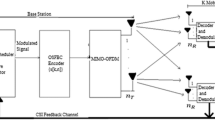Abstract
A cross-layer design (CLD) scheme for orthogonal space-time block coded MIMO systems with imperfect channel state information is presented by combining adaptive modulation and automatic repeat request, and the corresponding system performance is investigated over Ricean fading channel. The fading gain value is partitioned into a number of regions by which the modulation is adapted in terms of the region the fading gain falls in. The fading gain switching thresholds subject to a target packet error rate (PER) constraint are derived. According to these results, and using the generalized Marcum Q-function, we derive the theoretical formulae of average PER and spectrum efficiency (SE) of the system with CLD for both perfect and imperfect estimation in detail. As a result, closed-form expressions for average PER and SE are obtained. These expressions include some existing expressions in Rayleigh channel as special cases. With these expressions, the system performance in Ricean channel with perfect and imperfect estimation information can be evaluated effectively. Computer simulation for average PER and SE show that the theoretical analysis and simulation are consistent. The results show that the system performance will be effectively improved as Ricean factor increases, but it will be degraded as estimation errors increases.





Similar content being viewed by others
References
Aboutorab, N., & Mohammadi, A. (2011). A cross-layer design of wireless IP systems using effective bandwidth and MQAM adaptive modulation. Telecommunication Systems, 46, 343–351.
Aruna, T., & Suganthi, M. (2012). Variable power adaptive MIMO OFDM system under imperfect CSI for mobile ad hoc networks. Telecommunication Systems, 50(1), 47–53.
Au, E. K. S., Jin, S., McKay, M. R., Mow, W. H., Gao, X. Q., & Collings, I. B. (2008). Analytical performance of MIMO-SVD systems in Rician fading channels with channel estimation error and feedback delay. IEEE Transactions on Wireless Communications, 7(4), 1315–1325.
Cariou, L., & Helard, J.-F. (2005). MIMO frequency hopping spread spectrum multi-carrier multiple access: a novel uplink system for B3G cellular networks. Telecommunication Systems, 30(1–3), 193–214.
Chae, C.-B., Forenza, A., Heath, R. W., McKay, M., & Collings, I. (2010). Adaptive MIMO transmission techniques for broadband wireless communication systems. IEEE Communications Magazine, 48(5), 112–118.
Foukalas, F., Gazis, V., & Alonistioti, N. (2008). Cross-layer design proposals for wireless mobile networks: a survey and taxonomy. IEEE Communications Surveys & Tutorials, 10(1), 70–85.
Goldsmith, A. (2005). Wireless communications. Cambridge: Cambridge Univ. Press.
Gradshteyn, I. S., & Ryzhik, I. M. (2007). Table of integrals, series, and products (7th ed.). San Diego: Academic Press.
Huang, J., & Signell, S. (2009). On performance of adaptive modulation in MIMO systems using orthogonal space-time block codes. IEEE Transactions on Vehicular Technology, 58(8), 7838–7847.
Hussain, S., Azim, A., & Park, J. K. (2009). Energy efficient virtual MIMO communication for wireless sensor networks. Telecommunication Systems, 42(1–2), 139–149.
Jafari, A., & Mohammadi, A. (2009). A cross layer approach based on queuing and adaptive modulation for MIMO systems. Telecommunication Systems, 42, 85–96.
Liu, Q. W., Zhou, S., & Giannakis, G. B. (2004). Cross-layer combining of adaptive modulation and coding with truncated ARQ over wireless links. IEEE Transactions on Wireless Communications, 3(5), 1746–1755.
Lu, X. F., Zhu, G. X., Liu, G., & Li, L. (2005). A cross-layer design over MIMO Rayleigh fading channels. In Proceeding IEEE WiCOM 2005, Sept. 2005 (pp. 30–33).
Maaref, A., & Aissa, S. (2004). Combined adaptive modulation and truncated ARQ for packet data transmission in MIMO systems. In Proceeding IEEE GLOBECOM’2004, Nov. 2004 (pp. 3818–3822).
Maaref, A., & Aissa, S. (2004). A cross-layer design for MIMO Rayleigh fading channels. In Proceeding CCECE’2004, May 2004 (pp. 2247–2250).
Mahinthan, V., Rutagemwa, H., Mark, J. W., & Shen, X. (2009). Cross-layer performance study of cooperative diversity system with ARQ. IEEE Transactions on Vehicular Technology, 58(2), 705–719.
Proakis, J. G. (2001). Digital communications (4th ed.). New York: McGraw-Hill.
Jian, Q., & Aissa, S. (2009). Cross-layer design for multiuser MIMO MRC systems with feedback constraints. IEEE Transactions on Vehicular Technology, 58(7), 3347–3360.
Cariou, L., & Helard, J.-F. (2005). MIMO frequency hopping spread spectrum multi-carrier multiple access: a novel uplink system for B3G cellular networks. Telecommunication Systems, 30(1–3), 193–214.
Yu, X., Leung, S.-H., Mow, W. H., & Wong, W.-K. (2009). Performance of variable-power adaptive modulation with space-time coding and imperfect CSI in MIMO systems. IEEE Transactions on Vehicular Technology, 58(4), 2115–2120.
Zaidi, S. A. R., & Hafeez, M. (2008). Cross layer design for orthogonal space time block coded optical MIMO systems. In Proceeding WOCN ’08, May 2008 (pp. 1–5).
Zhang, H., & Gulliver, T. A. (2005). Capacity and error probability analysis for orthogonal space-time block codes over fading channels. IEEE Transactions on Wireless Communications, 4(2), 808–819.
Zhang, Y., & Leung, C. (2009). Cross-layer resource allocation for real-time services in OFDM-based cognitive radio systems. Telecommunication Systems, 42(1–2), 97–108.
Zhou, Z., Vucetic, B., Dohler, M., & Li, Y. (2005). MIMO systems with adaptive modulation. IEEE Transactions on Vehicular Technology, 54(5), 1828–1842.
Acknowledgements
The authors would like to thank the two anonymous reviewers for their valuable comments. This paper is supported by Research Fund of the Doctoral Program of Higher Education of China (20093218120021), National Natural Science Foundation of China (Grant No. 61172077), and the Fundamental Research Funds for the Central Universities (NS2012075).
Author information
Authors and Affiliations
Corresponding author
Rights and permissions
About this article
Cite this article
Yu, X., Zhou, T., Liu, X. et al. Performance of cross-layer design for orthogonal space-time block coded MIMO systems with imperfect CSI in Ricean fading channels. Telecommun Syst 57, 287–294 (2014). https://doi.org/10.1007/s11235-013-9854-3
Published:
Issue Date:
DOI: https://doi.org/10.1007/s11235-013-9854-3




